Welcome to the Badwater Ultramarathon: a 135-mile non-stop race over three mountain ranges in sweltering mid-summer desert heat with a vertical ascent of 13,000 feet
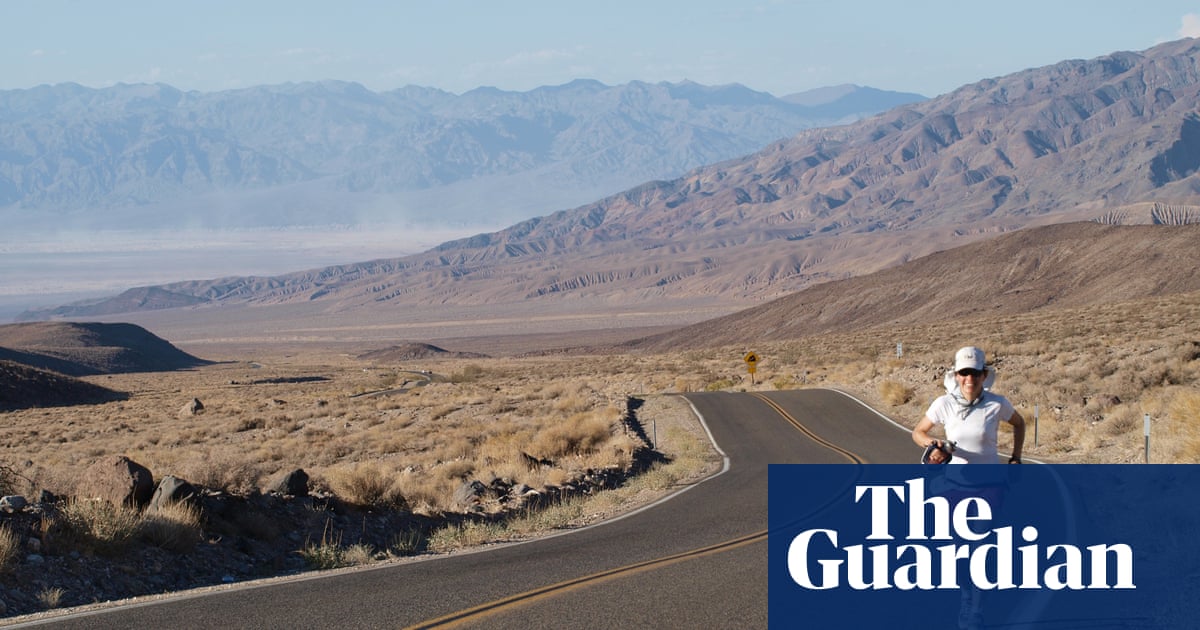
At 9.30pm on 23 July 2018, the second wave of runners lined up at Badwater Basin in Death Valley, 280 feet below sea level. The heat from the day had not cooled and the temperature was 118F (48C), even though the sun had long since gone down. To make matters worse, it was abnormally humid for the California desert. Sixty-two-year-old Pamela Chapman-Markle looked down the line of racers, recognizing about half the competitors from previous years. On a normal day she would be heading to bed in a half hour, and although her heart was racing with anticipation, she was already tired, acutely aware that she was about to miss two nights of sleep.
The starting gun fired and the runners set off on an incline. There would be 14,600ft of cumulative elevation for the runners to climb over the course of the 135-mile race ahead.
Chapman-Markle tried to calm her emotions and steady her heart rate. Five miles in, her throat was already sore from the still drier air, a drastic shift from the 90% humidity she trained in. With no light pollution, she could see the stars clearly, but at 62, her vision at night wasnt as good as it used to be, so she relied on a waist belt to light her path. For the first 20 miles, she passed runners, while others passed by her. Soon though, she wouldnt see anyone for long stretches.
Chapman-Markle would have to run the first 42 miles by herself before her crew could pace her just before daybreak. And even then, her pacers would follow behind her single file and switch off every five miles, returning the cool air conditioning of the car Chapman-Markles husband drove up ahead. Chapman-Markle would have to do with ice. Ice she put down her sports bra, ice she chewed, ice water she drank as she tried to contend with the overwhelming heat.
Last year, Chapman-Markle finished the Badwater 135 Ultramarathon in 34hr 30min, setting a record in the womens 60-plus age group for a third year in a row. Now 63, Chapman-Markle is the oldest female competitor in the race with designs on beating her record yet again. She is one of 95 competitors from 21 countries and 30 states accepted to run the ultramarathon this year.
The 135-mile race, which takes place this year from 15-17 July starting in Death Valley and and ending at Whitney Portal, 8,300ft above sea level, is often referred to as the worlds toughest footrace. Badwater 135 is considered by many ultrarunners to be the crown jewel of ultramarathons, which are defined as anything longer than a marathon. Temperatures climbed as high as 127F (53C) last year, and the asphalt road can get even hotter, causing the road to burn to runners feet. Chapman-Markle had the soles on three pairs of shoes melt last year. The race traverses three valleys and three mountain ranges, and after 122 grueling miles, runners face a steep final ascent to Whitney Portal at an elevation of 8360ft.
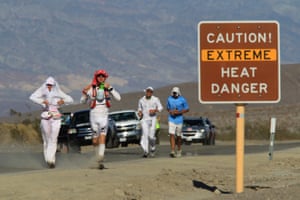
Risk of very, very serious medical issues in a race like Badwater is high, Shawn Bearden, a professor of physiology at Idaho State University and ultrarunner himself, said. Were not built to go 50 miles, 100 miles, or Badwater 135 miles.
But we are capable of it.
The biggest challenge running Badwater is the heat. Bearden, who has crewed and paced for the Badwater race once and studied the physiology of ultrarunning, notes that the reason competitors are able to complete it is the human ability to thermoregulate and cool down by sweating. But Badwater puts a massive strain on ones thermoregulation and therefore on ones gastrointestinal system. The only way youre going to survive Badwater is by consuming enough fluids and getting fluids and nutrients back in, Bearden explained. That means weve got to be able to sweat a lot and send blood to our skin to cool off, while sending blood to our muscles to keep us moving, while sending blood to our gut to absorb water and nutrients. So theres a massive strain on all of those tissues and systems.
And if a runner attempted to just drink water and not eat?
You have a good chance of dying by the end from a condition called hyponatremia, Bearden said, where you effectively dilute the salts in your blood because youre losing some of your sweat and youre only replacing water. Thats not to mention the muscle breakdown, which Bearden describes on a molecular level looking like a blender went through it, and takes months to repair, even if a runner feels good enough to run a week later.
*****
Matt Collins had just left the 100-kilometer mark at Forest Park in Queens and his pacer, a cross country buddy from college, along with it. His feet padded the ground in the fresh shoes that he had changed into at the stop, where he had tapped the blisters on the outside of his big and pinkie toes, and for a moment, his calloused and reddened feet were dry. He attempted to get down some pizza as he walked and readied himself for running another marathon and a half.
With each stride, his hamstrings and quads screamed. His legs had been cramping for miles, and he knew the pain wouldnt go away. Its not going to get any worse, he told himself.
Collins had been looking to the 100-kilometer marker since the beginning of the Great New York 100-miler, as he cut through Central Park heading North, ran along the Hudson and through the Bronx, and crossed the bridge into Queens with his pacer, where they laughed at Collins poor form reflected in store windows his heel strike too hard, hitting the pavement like a heavy man. They sang country songs as they ran along the water in Queens and passed picnics and soccer games. When they reached the Unisphere fountains at Flushing Meadows Corona Park, the two jumped in and let the water fall down on them.
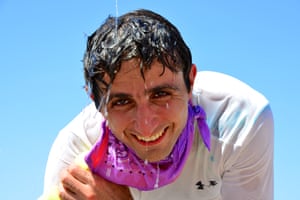
Now that the 62 miles were behind him, as well as the highs of the last 15, Collins was exhausted, daunted by the 38 miles ahead he had to face alone. He picked up his legs.
Collins also had Badwater, a mere three weeks away, on his mind. At 28, he would be the youngest competitor in the race, and the 100-miler he was currently running was in part in preparation for Badwater. Could he keep his hydration at a high enough level? He would need it for Badwaters heat. Aware of his tendency to go out too strong, he had begun todays race at a moderate pace. At Alley Pond Park in Queens, around 51 miles into the race, he took down four Dixie cups of pickle juice, savoring the salty brine of electrolytes and greedy for more.
Collins had been behind on training. Intramural hockey games probably dont get you ready for the hardest race in the world, Collins said, laughing at his attempts to stay fit as he finished up his MBA at Wharton Business School in Philadelphia. At times, he would come home from a night out with classmates and head out on a run at 5am. Maybe because were a little younger, we definitely have more of a cowboy attitude, Collins said about running ultramarathons with his pacer for Badwater, another college cross country buddy.
But Badwater is the first race hes pored over online resources for information on how to run the course, even sparing a few minutes during the Great New York 100-miler to talk to the race director, who ran Badwater, for tips.
Since then, he has run two to three 20-mile runs a week in his parents basement, with the space heaters cranked up until he blew a fuse and had to rearrange the outlets. On the other days of the week, he runs up to six miles, and will sit in the sauna set at 160F for as long he can handle. The heat impacts everything else, he said. If youre not keeping cool, keeping smart, then you fall behind on electrolytes, which means your body cant take in food, which means you cant really move forward, and youre cramping.
Collins training is in sharp contrast with Chapman-Markle. After her first ultramarathon (or marathon for that matter), a 100-miler through the woods in Texas aged 55 that left her hypothermic, dangerously dehydrated, and with a stress fracture in right tibia, her grown children drove her to the hospital, where she had IV fluids hooked up to her arm. No more, Mom, they told her. Try something else.
Chapman-Markle instead decided to do more research on how to properly train for an ultramarathon. Forty-five ultramarathons later, six this year alone, and after two years focusing on proper form, Chapman-Markle has a strenuous, consistent training schedule and strict recovery routine. She has not only remained healthy, but has been breaking USA Track & Field records for her age group and is pursuing the world records now.
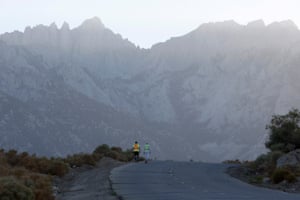
Based in Galveston, Texas, Chapman-Markle runs in 38C weather with 90% humidity regularly, hitting the roads around 2 or 3pm on the weekdays while the sun is still high in the sky when she gets home from her job as a nurse anesthetist. Every other weekend, Chapman-Markle and her husband, who has crewed her since her second race, head to her condo 30 minutes north of Austin in the hills. There he will hop on a bike as she runs the hills for two to four hours. The closer I get to Badwater, the more mileage Ill add on, so sometimes, I do two-a-day trains, I might go out for two and a half hours in the morning and an hour and a half at night. To prep for the 13-mile hike at the end of Badwater, shell put on a 10-pound weighted vest and hike her running route. I think you can walk it faster than you can run it, because its an 8% to 10% grade, she said of the final push.
And on the recovery side of her preparation, Chapman-Markle is just as thorough: She sits in the sauna built into her house every night for 30 to 40 minutes to help her heat train before heading to bed for seven to eight hours.
*****
Consistency is key to ultrarunning and completing Badwater 135, Shawn Bearden said.
Consistency is several fold, he notes, pointing to consistency in ones day-to-day training and being consistent in ones training over years, and keeping ones diet whether high-carb, high-fat, or otherwise consistent. It takes years for people to build up really to being able to comfortably handle these very long distances.
This is also one reason runners in Badwater are, on average, older. The average age for Badwater 135 participants is 47 years old, with the oldest at 72. There are a few other reasons Bearden points to: as we age, we develop more of slow-twitch muscles that help on long runs. Psychological maturity comes with age. Older people have a better understanding that the sun will come up tomorrow, Bearden said. And it takes years for people to develop what he calls craft: the skills of ultrarunning and understanding the limits and needs of ones body.
For 51-year-old Filipino Tess Bibal Leono, the biggest challenge to her training is the stray dogs. An analyst for the Asian Development Bank in the Philippines, Leonos work brings her to islands throughout the Pacific, where many hotels dont have gyms and she will have to run on the road. Packs of stray dogs will begin to follow her and chase her if she continues running. If I see a dog, I try to stop running. So it kind of limits your training, she said.
Leono ran the Badwater 135 in 2016 and 2018, quitting in 2018 after 80 miles due to acid reflux. Too excited for the race, she hadnt slept the night before, and with record heat and unusual humidity, the event had the lowest completion rate in its 41-year history, with many of those disqualified by the time limit or quitting the race having finished the race in previous years.
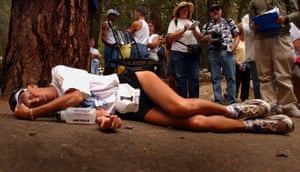
I didnt prepare, Leono said. I thought I prepared well. Her training for the 2018 Badwater had been disrupted at times by her busy travel schedule. This year, she made a commitment to get in at least 30 minutes a day if traveling, and she will often get back to the hotel after work and nap, waking at 9pm or 12am to get a run in the hotels gym even if its just five kilometers. She has been running marathons on the weekends and tack on an extra 10 kilometers as the rest of the marathoners head home.
The final hurdle for competitors is the psychological aspect. I really think that most people who are capable of running a full marathon really could step up and run 100 miles, Bearden said. Its all about your mindset and how you can handle every cell your body screaming and telling you, this is stupid. You should stop.
Thats part of being an ultrarunner, you always get extremely depressed because youre sleep-deprived, and fluids and sodium arent proper, and your brain will want you to stop, to quit, or [ask] why are you doing this? I know why Im doing this, Chapman-Markle said. The one thing I do have is mental strength. And I think thats probably 65% of running a race like this. Chapman-Markle tries to stay positive and think nothing but grateful thoughts. If bad thoughts do come in, I think my body needs something so I just try to figure out what it needs, give it to it, and get back to my happy thoughts, she said.
Its obviously very physically hard. Mentally it is probably harder, Collins said. He recalled his first ultramarathon, a 50-miler he participated in to raise money for Roswell Park Cancer Institute, where his brother was battling leukemia. For me, I had a reason to be out there so that eliminated a lot of the temptation of dropping out and seeing theres an escape valve. For me, there was just the finish line, he said.
*****
For Collins, the 100-mile Great New York Running Exposition didnt prompt the usual roller coaster of emotion he normally experiences during an ultramarathon. Collins finished first, crossing the finish line at 16hr 11min, jubilant to sit down and cheer on his friend who had closed in on his lead and finished first for the women.
I felt really excited for what were going to do in three weeks [at Badwater], he said. It was exactly the test I wanted it to be.
Collins was clear that the race was an exception. It was the first one ever I havent cried, he said. He had run the Great New York 100-miler before, the terrain was relatively flat, and the weather, at 80F, mild. Badwater would be another beast.
But Collins has learned a lot since his first ultramarathon at 24 and about what his body can handle. He tried to drive home by himself from that first 50-miler and, in sheer exhaustion, put the car into an embankment. This time, he booked himself a hotel in Times Square where the race ended, so he wouldnt have to walk too far.
You just go to such insane lows, and that bring you to such amazing highs, Collins said. Im not usually good at race specific training, which this race is a bit of an aberration from that.
Before heading off to the desert this weekend, Collins flew to Puerto Rico for the Fourth of July weekend, taking the week before Badwater off from any strenuous runs. When asked what hed do with his week off, he said with a smile: Probably nothing productive.
Read more: https://www.theguardian.com/lifeandstyle/2019/jul/12/badwater-ultramarathon


Recent Comments